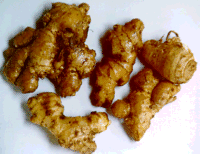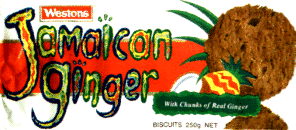
Ginger (Zingiber officinale Rosc.) is thought to have been introduced into Jamaica about 1525. By 1547 though, it is reported that the export of ginger amounted to over 22,000 quintals (1.2 million Kg).

Prior to 1740, the ginger was associated with the Parish of St Ann, where it had first been planted by the Spanish. After that the Christiana region took over when it was recognised that the soil and climatic conditions were especially suitable for the growing of ginger. In 1980, a survey by the International Trade Centre reported that 1,100 acres of ginger were planted in Jamaica in the central range areas of Clarendon, Manchester and Trelawny.
Between the 1930's and 1960's, Jamaica was listed as one of the three largest producers of ginger in the world, along with India and Sierra Leone. A 10-mile radius around Christiana was identified as the region which grew the finest ginger in the world. Since then the production has fallen significantly, from close to 2 million kilogram of ginger in 1953 to around 0.4 million kilos in 1995.
The chief constraint for production seems to be associated with peeling, as this is time consuming and costly. An average worker can peel about 11 Kg of green ginger per day, which amounts to less than three (3) Kg of dried ginger. Another problem is that it is difficult to recruit new young staff. They are generally unwilling to take part in the peeling, which is usually left to older family members. Preparation involves removing the soil, then peeling the outer skin and spreading on mats in the sun for about 10 days in the sun, to reduce the moisture content to 10-12%
 Biscuit wrapper from Australia
Biscuit wrapper from Australia
The sensory perception of ginger in the mouth and the nose arises from two distinct groups of chemicals:
- the volatile oils, a mixture of terpenoids which imparts the characteristic aroma and
modifies the taste.
- the non-volatile pungent principles, such as the gingerols
and zingerone which produce the "hot" sensation in the mouth.
| The gingerols are susceptible to transformation to less-pungent compounds such as shogaols and zingerone. |
HPLC has been used to measure the ratio of [6]-gingerol to [6]-shogaol which gives an indication of the extent of pungency degradation. The lower the value the higher the pungency loss.
About 2-3% of ginger oil is obtained from the dried rhizomes on steam distillation. The
main constituents of the volatile oil include:
35% zingiberene
10% AR-curcumene
10% beta-sesquiphellandrene
8% bisabolene
6% dextro-camphene
3% beta-phellandrene
2% 1,8-cineole
other important components include:
Ginger oil is often used for cordials and ginger wine and preserved ginger is a very
popular confection and the main markets are the USA, Western Europe and Japan.
An IR spectrum of ginger oil is available in
JCAMP-DX file format.
"Ginger farmers gather" Feature A14 in The Gleaner, June 15th, 1996.
"Ginger - A short economic history", D.W. Rodriquez, Agricultural Planning Unit,
Ministry of Agriculture and Fisheries, JAMAICA, 1971.
"Food Flavourings", Edited by P.R. Ashurst, Blackie Academic & Professional,
an imprint of Chapman & Hall, Wester Cleddens Road, Bishopbriggs, Glascow, G64 2NZ,
UK. 2nd edit. 1995.
See also the ginger
page by Gernot Katzer.
Return to links to the chemistry of other Jamaican items, including spices and fruit and vegetables.
Copyright © 1995 by Robert John Lancashire, all rights reserved.
Created and maintained by Dr. Robert J. Lancashire,Created Feb 1995. Last modified 24th November 1999.
URL http://wwwchem.uwimona.edu.jm:1104/lectures/ginger.html